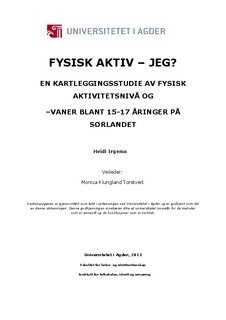| dc.description.abstract | Background: Some studies point to the fact that the youth in Norway do not fulfill the recommendations made by the Health Government regarding physical activity. When it comes to physical activity level and habits in the south of Norway in particular, there is however a lack of information. The purpose of this master’s thesis was to describe the level and habits of physical activity amongst young people, 15-17 years old, in the South of Norway, by examining the activity level in their leisure time, type of physical activity, the motives for being physically active, the physical activity behavior by using the Stage of Change model, possible gender differences regarding physical activity level and habits, and, finally, if there is a relationship between the physical activity level of the youth and their parents` education level.
Methods: This master`s thesis is designed as a cross-sectional study, and is part of the project Aktiv Ungdom med Overskudd (AUO). AUO is a randomised controlled study (RCT), and the descriptive data from AUO will be used in this master`s thesis. Physical activity was registered in a questionnaire, which included questions regarding physical activity level and habits. First- year students from 23 different high schools in the South of Norway, were invited to participate in this study. Seventeen high schools agreed to participate. 2653 high school students were invited to participate, of these there were 43 students that choose not to participate, giving a response rate of 98,4 %. Two thousand and ten students answered the questionnaire, 165 responses were excluded from the analyses, and the database in this master`s thesis is therefore based on 92,2 % of the selection.
IV
Results: 11 % of the students were not physically active during the week in their leisure time, 48, 4 % of the students were physically active for 1-4 hours during the week, 20, 8 % were physically active for 5-7 hours during the week, and 17, 8 % of the students were physically active eight hours or more. Boys were more active than girls. The most popular activities among the youth were endurance training, team-sport activities such as football and handball and strength training. The most important motive for being physically active, which was the same for both boys and girls, was “having fun”. The motive “increased muscle mass/strength” was the most dominant motive for the boys. For the girls the most important motive was “reduce/maintain body weight”. In terms of the Stage of Change model 5,8 % were classified in the precontemplation stage, 17 % in the contemplation stage, 23,6 % in the preparation stage, 12,3 % in the action stage and 40,4 % in the maintenance stage.
Conclusion: One of 10 (11 %) of the high school students in the age group 15-17 years old in the South of Norway appear to be physical inactive in their leisure time. In proportion to the Health Government recommendation of 60 minutes daily physical activity with moderate to high intensity are about 7 of 10 (69,2 %) of the students some physical active but not enough, and about 1 of 5 (17, 8 %) students are active enough. It is therefore important to promote physical activity among youth in the South of Norway, especially when it comes to girls, who are less active than boys. Physical activity should also be promoted, special among those with low social position.
Key words: Youth, adolescent, lifestyle, physical activity level, physical activity habits, cross sectional study | en_US |
